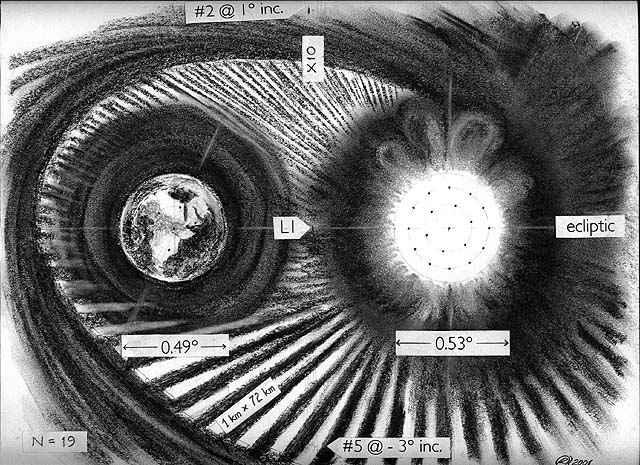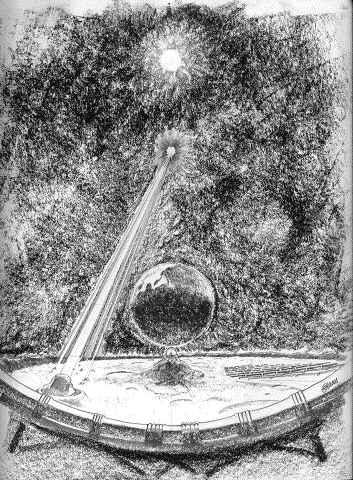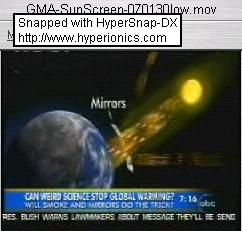 |
 |
 |
 |
 |
 |
 |
 |
 |
 |
 |
as appearing in the Summer 2001 issue of Whole Earth Review
Lots of people talk about global warming, but few offer a solution, and none are cheap. The Kyoto remedy is to reduce the emission of greenhouse gases worldwide by fiat. But stuffing corks into every smokestack and tailpipe will be expensive and politically problematic. In the US alone, cutting CO2 emissions to 80% of the 1990 level may cost $3.6 trillion (1990 dollars), 30 times Apollo’s price tag.
On the other hand, damage from unmitigated climate change will surely be vast -- at least $200 trillion over the next century.
The idea of placing mirrors in space dates back to Tsiolkovsky and Tsander in the 1920s. In space, even insubstantial sunlight exerts pressure, so a mirror generates continuous thrust without any rocket fuel.
Space mirrors can also reduce the amount of sunlight striking the earth! To work as a parasol, a sail must hold itself between the Earth and the Sun for many years. The ideal spot is the L1 Lagrange point, 1.5 million kilometers inside Earth’s orbit on the Earth-Sun axis. A parasol will have to actively reconfigure itself to maintain this somewhat unnatural position, but this should be achievable by mid-21st century distributed automation. While providing free thrust to a space mirror, solar photons cannot complete their journey to Earth to heat us up. Intercept enough photons in space, and greenhouse gases become irrelevant!
How much shading is enough? Between the mid-16th and 17th centuries, the sunspot cycle shut down, reducing solar output by a mere 0.25%. Astronomers call this “the Maunder minimum”27; historians call it “the Little Ice Age”. The Thames River froze, European population growth stalled, crops failed, and sea ice cut off Iceland from Europe.
During the Maunder Minimum, Tycho Brahe, noted Danish astronomer, recorded winter temperatures 2.7°F below average. We note that the lower limit of IPCC's estimated Greenhouse temperature change is also 2.7°F, but in the opposite direction. Therefore, creating a mirrored Maunder Minimum should let us adjust global temperature just to our liking.

Our calculations indicate a need for 390,000 square kilometers of space mirrors, orbiting at L1. This giant rheostat in the sky has some major advantages.
It is:
Constructing these mirrors will be greatest industrial enterprise yet attempted by the human race (second only to two heroic centuries of digging up fossil fuel and burning it). Lifting these giant shields off the surface of the Earth is out of the question. Only offworld resources will do: lunar mining, processing and launch facilities, harvesting asteroids, and robotic manufacturing.

How could we pay for this scheme? With utility premiums.
At Earth orbit, 1,400 megawatts of solar energy pass through every square kilometer. These mirrored sails and shields are also power generators. If just 10% of this absorbed energy is converted into electricity and beamed to Earth by microwave, each ten square kilometers of sail would displace a billion-dollar carbon-burner on the ground, eliminating Greenhouse pollution.
Together the space mirrors could provide the total planetary electrical demand projected for the year 2050, i.e., 300 quads/year. Replacing the world’s generating plant by 2050 will cost roughly $20 trillion anyway. Why not set funding aside now, for clean energy from space that also keeps us cool?
Space mirrors may not only give humanity a better climate on the ground, but also open the door to developing the solar system, a gift that will keep on giving. Mirrors have yet another historic function: silent signals across long distances. Focussed reflections can show Inquiring Minds Out There that we Earthlings have got it going on!
Ken Roy is an engineer working in Oak Ridge amidst relics of the Manhattan Project. Most of his writing concerns how space technology will affect the future. Notably, “Ship Killers from Space”, a cover story of the prestigious Proceedings of the US Naval Institute, developed the strategic implications of basing kinetic energy weapons in low earth orbit.
Robert Kennedy is president of the Ultimax Group Inc., a corporation distributed across 11 time zones from Moscow to L.A. He speaks enough languages to start bar fights in all of them. Robotics engineer, amateur historian, and jack of all trades, he spent 1994 working for the House Science Committee's Subcommittee on Space as ASME's Congressional Fellow. On the Sputnik anniversary in October 1997, he managed to make the Russian evening news. Robert telecommutes from Oak Ridge, Tennessee, where he resides with his wife, numerous cats, the occasional horse, and a yard full of trees and Detroit iron.
I thank my co-author Ken Roy PE, as well as John Wharton, Eric Hughes, Dwayne A. Day Ph.D., Mike Markowitz, Steven McCauley, Ph.D., and B. Derk Bruins Ph.D. All mistakes are my responsibility.
1. Hayden, Thomas, “Curtain Call” in Astronomy Magazine, edited by Bonnie Bilyeu Gordon, January 2000, pp. 45-49.
2. Krause, Helmut G. L., “Astronomical Constants of the Solar System” in Mark's Standard Handbook for Mechanical Engineers, Eighth Edition, edited by Theodore Baumeister, McGraw-Hill Book Company, New York, 1978, pp. 11:104-107.
3. Manne, Alan S. and Richels, Richard G., “CO2 Emission Limits: An Economic Cost Analysis for the USA” in The Energy Journal, edited by Leonard Waverman, Washington, D.C., 11(2), April 1990, pp. 51-74.
4. McInnes, Colin R., Solar Sailing: Technology, Dynamics and Mission Applications, Praxis Publishing, Chichester, UK, 1999.
5. Stark, John P.W., “Celestial Mechanics” in Spacecraft Systems Engineering, edited by Peter Fortescue and John Stark, John Wiley and Sons, Chichester, 1991, pp. 59-81.
6. various, Statistical Abstract of the United States: 1994 edition, (US Dept. of Commerce, Bureau of the Census, USGPO: 1994)
7. Fagan, Brian, The Little Ice Age: How Climate Made History: 1300-1850, Basic Books, 2000
15Feb2001; post original as presented to STAIF 2001
15Feb2001; covered on ABC Evening News
20Feb2001; replace Table 1 with Tables 1-3.
23Feb2001; upload figures and equations.
25April2001; presentation of "AntiVenuforming Terra" at 27th Asilomar Microcomputer Workshop.
24May2001; update figures in Tables 1-3 to reflect limb darkening, L1 stationing.
07Jul2001: "Mirrors & Smoke" appears in Whole Earth Review.
24Sep2001: Finish computer graphic animation of "Mirrors & Smoke" for Belgian national television RTBF - Mati�ére Grise (in English, ’Grey Matter“. Low-rezz version of CG video archived here.
02Nov2001: Deliver invited physics seminar "Mirrors & Smoke: Changing the Solar Constant to a Solar Variable" at California Polytechnic State University, Pomona.
14Nov2001: Deliver invited engineering seminar "Mirrors & Smoke, and Other Shady Schemes" at Stanford University Computer Systems Laboratory Colloquium (EE380).
21Nov2001: Deliver luncheon lecture with updated economic forecasts to Friends of Oak Ridge National Laboratory.
30Jan2007: Advise ABC News Good Morning America re technical background and graphic to illustrate mirrors-in-space concept:  © American Broadcasting Company. Note: Not to scale.
© American Broadcasting Company. Note: Not to scale.
07Aug2009: Co-author Ken Roy discusses "Geoengineering to Fight Climate Change" at 67th World Science Fiction Convention (Worldcon aka Anticipation), Montreal, Quebec, Canada. The question with co-panelists Paolo Bacigalupi and S.M. Stirling, "From giant space mirrors to salt water
sprays, are there engineering solutions to climate change?" See panel session #2-340, 8 PM, in room P-512DH Science and Space track. See also page 51 of the program.
Back to Directory of White Papers

For product or dealer inquiries within the USA & Canada, call:
West Coast: (888) ULTIMAX..................................................................East Coast: (800) ULTIMAX
Outside USA: +1 (865) 405-5806 -- note number has changed
or write to us:
The Ultimax Group, Inc.
112 Mason Lane
Oak Ridge, Tennessee, USA 37830-8631
or send email to robot#ultimax_com
The entire content (images and text) of these pages is copyrighted and may not be distributed, downloaded, modified, reused, re-posted or otherwise used without the express written permission of the authors.
Privacy Policy: The Ultimax Group Inc., will never sell our customer list or distribute our customer's personal data to others without permission.
Network Abuse Policy: All incidents of suspected spam, sporging, Joe jobs, etc, derived from the misuse of the data on these pages will be investigated, reported, and prosecuted to the fullest extent of the law.
These pages last updated 28 November, 2011
In all written email addresses on these pages, a hash-mark (#) has been substituted for the at-sign (@), and an underscore (_) for the period (.) in order to defeat spammers' spiders.